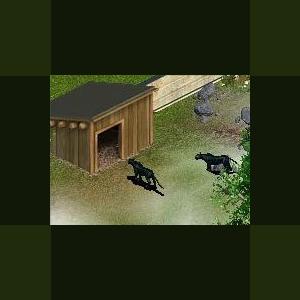About This File
Black Puma
Author: LAwebTek
Black (Melanistic) pumas, also known as cougar, panther, mountain lion, night screamer, catamount, mountain devil, and king cat, are not a separate subspecies of puma, but rather a color variation within the species. Black pumas are extremely rare to the extent that no one has ever captured one and placed it in captivity. There are very few photographs or sightings of the black puma, although clearly enough to prove that the animal does exist and is not a myth as was once believed.
Black pumas are believed to reside primarily in Canada and the northern most parts of the United States. The black color is an adaptation to the colder climate, while pumas in most of North and South America have a redish-brown color. The black puma's ideal habitat is mountainous forests up to 16,000 feet. Pumas are very territorial and mark their territory. They are carnivores that are active both day and night and their prey consists of a variety of mammals, birds and fish. If larger animals such as white-tail deer, caribou and moose are not available, the puma is able to adapt quickly and switch to smaller prey such as raccoon, skunk, birds and fish. If hungry enough, the puma will even take down horses, cows, and other livestock and so it has a bad reputation by farmers.
Black pumas can range in weight from about 150 lbs. to 200 lbs, the male is larger than the female. Their tail can be almost as long as their body length and is used for balance. Using sight and sound more then scent, the puma stalks its prey. Their back legs are more developed than their front legs which allows them to ambush prey and jump on their backs to go in for the kill. Pumas have the ability to leap an incredible 40 feet. The strong muscle development in the back also enables the puma to maneuver in the more difficult mountainous areas and steep ravines. When hunting, the puma grips into the victims neck and either snaps the prey's neck or grips into the windpipe until it suffocates. After the puma kills its victim, it will cover it with debris to reduce the risk of other animals finding the carcass and to prolong the food.
Males breed with a large number of females to increase reproductive success. One male will have a very large range and all the females, who have much smaller ranges are resident in the male's territory, will mate with that one male. The male will search for days for the female(s), covering 50 km in a day and night. The puma, who hunts silently, will howl when ready to breed. Pumas do not choose a particular season to mate. The females will mate starting around age two or three and will select a cave or other shelter as a spot for her cubs' birth. One to six cubs may be born, blind and helpless. They gain vision after two weeks. The cubs will grow its parents' muscular jaws, wide gape, and long teeth which are designed to clamp into it's prey, as well as to eat it. While they are cubs, the female will protect and feed them. This will continue until they are about a year and a half old and can defend themselves.
Updated 2010-10-30
Just to save space with less in zip and smaller image.



Recommended Comments
There are no comments to display.
Create an account or sign in to comment
You need to be a member in order to leave a comment
Create an account
Sign up for a new account in our community. It's easy!
Register a new accountSign in
Already have an account? Sign in here.
Sign In Now